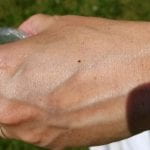“Tick species differ in where they prefer to hang out, but it is possible to come into contact with a tick anytime you leave the pavement.” – Don’t Get Ticked NY

There are many tick resources out there and almost all of them include recognizing and avoiding tick habitat as a strategy for avoiding a tick bite, including ours. But how reasonable is this as a sole strategy?
Part of that answer depends on how closely you are able to follow your original plan.
We know from conducting tick monitoring on school grounds and parks that athletic fields are low-risk, but not no-risk areas. And while the chances of picking up a tick are slight while playing soccer, following a wayward ball into the woodline increases the likelihood of exposure significantly.
Or let’s say you want to go for a walk in the woods. You can certainly choose trails that are wider and more beaten down, and thus less likely to have vegetation where ticks are lurking. But higher trafficked trails have, well, more traffic. The chance that you will need to step to the side to let another hiker or biker by is high. And, in 2020, social distancing means a lot more time off trail than usual.

Okay, then. Let’s stick to the road! Are you safe there? It’s certainly has less-risk, but like athletic fields, is not no-risk.

It’s even riskier for our dogs as they are fixed on interesting smells while remaining blissfully unaware of ticks. Even leashed they are more likely to brush up against tick infested vegetation. This was discussed in the blog post, Tick IPM – The Dog Zone.
And while you might feel safer as the temperature drops, remember that adult blacklegged ticks can be active through the winter and into early summer. This was discussed in the blog, Ticks don’t care what month it is.
Lest you consider never going outside again, you need to balance the risk of a tick-borne disease with the health risks of remaining indoors. You CAN successfully avoid tick bites!

So, while some areas ARE less risky than others, it is best to rely on multiple strategies to keep you and yours safe from a tick bite and the pathogens that can cause disease. These include:
- Dressing to exclude ticks
- Wearing tick killing clothing (I like to think of this as the “set it and forget it” method)
- Applying repellents
- Conducting a daily tick check
- Protecting your pets
- Properly removing attached ticks (use pointy tweezers!)
Need helpful reminders? The TickApp contains information on ticks and tick bite prevention, asks you to complete a daily log on your activities to help researchers, and you can send pictures of your ticks for identification.
For more information on ticks and how to protect yourself, visit our website, www.DontGetTickedNY.org.
Let’s stay safe out there.